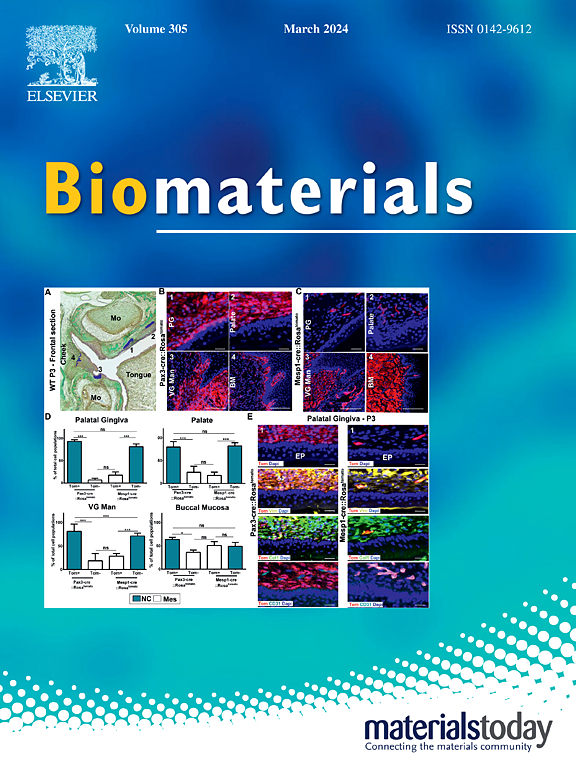Innovative DNA tetrahedron inspired by ancient mortise-and-tenon technique offers new immunotherapy strategy for metastatic breast cancer
IF 12.8
1区 医学
Q1 ENGINEERING, BIOMEDICAL
引用次数: 0
Abstract
Framework nucleic acids effectively meet the demands for precise size control and accurate targeting in the design of drug delivery systems, while developing a controllable drug delivery system with low immunogenicity and high efficiency for delivering nucleic acid drugs to the tumor immune microenvironment (TIME) remains significant challenge. Inspired by ancient Chinese mortise and tenon joint structures, this study develops an intelligent self-assembling DNA tetrahedron (TDN@siCSF-1R), which consists of a gapped DNA tetrahedron (TDN) and a therapeutic siRNA against Colony-Stimulating Factor-1 Receptor (siCSF-1R) that non-covalently bind with TDN via its gap, aiming to target tumor-associated macrophages (TAMs) and inhibit the CSF-1R pathway. Additionally, a CD206 mRNA-responsive sequence is introduced into the gapped TDN, triggering the site-specific release of siCSF-1R in M2-like TAMs, thereby achieving the precise targeting of CSF-1R in M2-like TAMs and reducing off-target effect. The mortise-and-tenon-like TDN@siCSF-1R synchronously combines the self-assembly flexibility and structural stability, significantly inhibiting 4T1 tumor growth, lung metastasis, and tumor recurrence after resection in vivo. Furthermore, it repolarizes M2-like TAMs and activates infiltrating T cells in TIME, thereby reshaping the immunosuppressive microenvironment, and offering a promising strategy for the clinical application of cancer immunotherapy.
受古代榫卯技术启发的创新DNA四面体为转移性乳腺癌提供了新的免疫治疗策略
框架核酸有效地满足了给药系统设计中对精确尺寸控制和精确靶向的要求,而开发一种低免疫原性、高效的可控给药系统将核酸药物递送至肿瘤免疫微环境(TIME)仍是一个重大挑战。受中国古代榫榫结构的启发,本研究开发了一种智能自组装DNA四面体(TDN@siCSF-1R),该四面体由一个缺口DNA四面体(TDN)和一个靶向集落刺激因子-1受体(siCSF-1R)的治疗性siRNA组成,该siRNA通过TDN的缺口非共价结合,旨在靶向肿瘤相关巨噬细胞(tam)并抑制CSF-1R途径。此外,在缺口TDN中引入CD206 mrna响应序列,触发siCSF-1R在m2样tam中的位点特异性释放,从而实现CSF-1R在m2样tam中的精确靶向,减少脱靶效应。类似榫眼的TDN@siCSF-1R同步结合了自组装灵活性和结构稳定性,在体内显著抑制4T1肿瘤生长、肺转移和肿瘤切除后复发。此外,它使m2样tam重极化并激活浸润性T细胞,从而重塑免疫抑制微环境,为癌症免疫治疗的临床应用提供了一种有前景的策略。
本文章由计算机程序翻译,如有差异,请以英文原文为准。
求助全文
约1分钟内获得全文
求助全文
来源期刊

Biomaterials
工程技术-材料科学:生物材料
CiteScore
26.00
自引率
2.90%
发文量
565
审稿时长
46 days
期刊介绍:
Biomaterials is an international journal covering the science and clinical application of biomaterials. A biomaterial is now defined as a substance that has been engineered to take a form which, alone or as part of a complex system, is used to direct, by control of interactions with components of living systems, the course of any therapeutic or diagnostic procedure. It is the aim of the journal to provide a peer-reviewed forum for the publication of original papers and authoritative review and opinion papers dealing with the most important issues facing the use of biomaterials in clinical practice. The scope of the journal covers the wide range of physical, biological and chemical sciences that underpin the design of biomaterials and the clinical disciplines in which they are used. These sciences include polymer synthesis and characterization, drug and gene vector design, the biology of the host response, immunology and toxicology and self assembly at the nanoscale. Clinical applications include the therapies of medical technology and regenerative medicine in all clinical disciplines, and diagnostic systems that reply on innovative contrast and sensing agents. The journal is relevant to areas such as cancer diagnosis and therapy, implantable devices, drug delivery systems, gene vectors, bionanotechnology and tissue engineering.
 求助内容:
求助内容: 应助结果提醒方式:
应助结果提醒方式:


